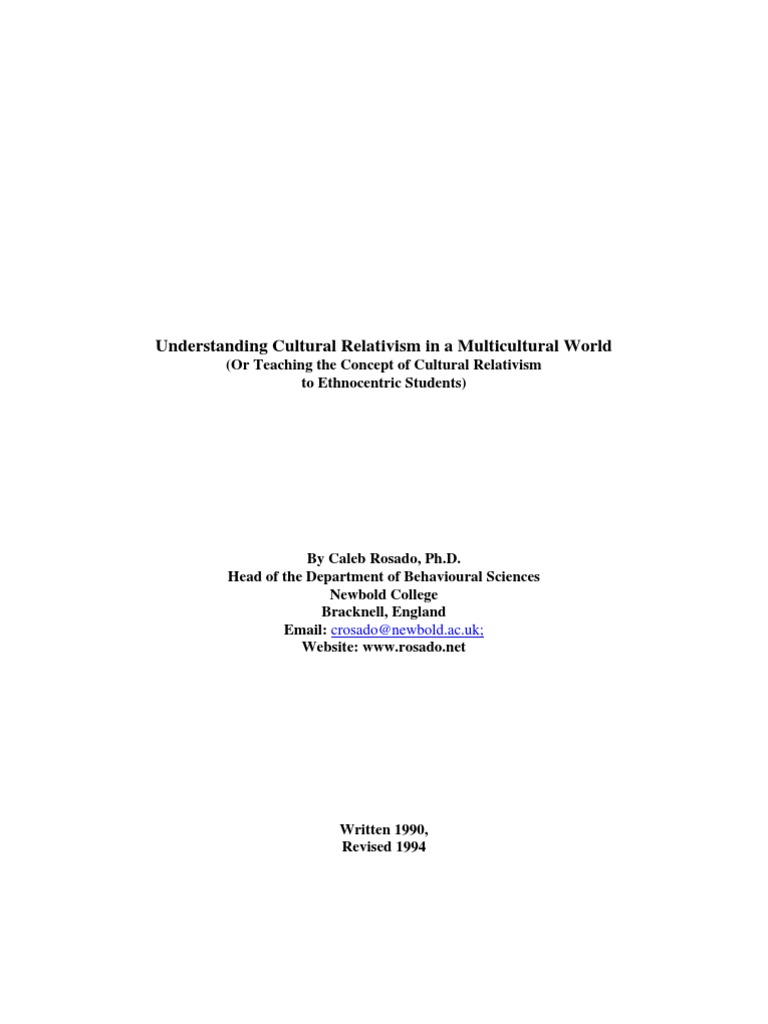Cultural relativism is a complex and often contentious topic that warrants a deep dive into its multifaceted dimensions. The concept posits that beliefs and practices must be understood in the context of an individual’s own culture rather than through the lens of another culture. To unravel the intricacies of cultural relativism effectively, we can employ a graphic organizer, which serves as a visual representation of ideas and relationships. This method not only enhances comprehension but also facilitates a deeper engagement with the topic. Imagine a tapestry, woven from diverse strands of thought, culture, and experience; cultural relativism is akin to this tapestry, where each thread contributes to the richness of the whole.
At the foundation of cultural relativism lies the principle of epistemic humility. This entails an acknowledgment that one’s worldview is inherently limited and that understanding is cultivated by engaging with diverse cultural perspectives. The premise is not to assert that all beliefs are equally valid, but rather to explore the significance behind them. This exploration begins with the recognition that every culture develops its own parameters for morality, appropriateness, and value. Hence, instead of critiquing behaviors unfamiliar to one’s cultural framework, the focus shifts toward understanding the historical and social contexts that shape these behaviors.
To construct an effective graphic organizer, one can delineate key components of cultural relativism. Firstly, the core principle—understanding practices and beliefs within their cultural contexts—can be placed at the center of the organizer. Radiating out from this central idea, several primary branches can emerge, encapsulating important facets such as historical context, moral implications, and perspectives on cultural diversity.
One prominent branch that can be developed is the historical context. Each culture is a product of its unique historical circumstances. The legacies of colonization, migration, and economic change have indelibly shaped cultural practices around the globe. For instance, ritualistic practices that may seem bizarre to outsiders often have deep historical significance, acting as a repository of collective memory and identity. By illustrating these connections visually, the graphic organizer can effectively clarify how history influences current cultural norms.
Another crucial aspect is the moral implications of cultural relativism. This segment of the organizer can delve into the ethical dilemmas that arise when one examines controversial practices. For instance, practices such as arranged marriage or specific forms of religious worship may raise questions about autonomy and individual rights. The challenge emerges when attempting to broker respect for cultural differences with the advocacy for universal human rights. Visual aids within the organizer can highlight these conflicts and encourage critical thinking about balance, allowing for a nuanced view of how cultural practices interact with ethical standards.
Moreover, perspectives on cultural diversity warrant attention in any discussion on cultural relativism. Through this lens, the implications of globalization can be scrutinized. As cultures increasingly intersect through migration, technology, and commerce, the potential for cultural homogenization poses a threat to unique traditions and practices. A graphic organizer can visually demonstrate how cultural relativism advocates for the preservation of diverse identities while simultaneously embracing intercultural dialogues that enhance mutual understanding.
As the tapestry of cultural relativism expands, it is vital to consider counterarguments. Critics may argue that cultural relativism enables harmful practices by providing a shield against moral critique. This contention highlights a crucial aspect: the risk of complacency. One of cultural relativism’s strengths lies in its encouragement of dialogue. Engaging critically with differing practices—while remaining firmly rooted in the understanding that every culture has its reasons—can foster constructive discourse, challenging harmful traditions without outright dismissal.
In exploring these intricate notions, it is beneficial to employ metaphors that resonate with the concept of cultural relativism. Cultures can be likened to islands in an expansive ocean, each with its unique flora, fauna, and ecosystems. Some islands, while enchanting, harbor dangerous elements, while others offer remedies for the maladies affecting neighboring islands. In this analogy, cultural relativism acts as the ocean current, connecting these islands and facilitating understanding. This imagery serves to emphasize the importance of exposure, dialogue, and learning. It is through this interconnectedness that cultures evolve and adapt, enriching the collective human experience.
Transitioning from metaphor to practice, the application of cultural relativism can also be illustrated in various real-world contexts. The fields of anthropology, sociology, and even international relations benefit from this approach. By employing graphic organizers in academic or professional environments, individuals can visually map cultural frameworks, recognizing the contextual nuances that dictate human behavior and societal norms. These tools serve as invaluable resources for students, educators, and practitioners alike, fostering an environment of inquiry and respect.
In conclusion, cultural relativism is a vast and intricate landscape, one that is best navigated with the aid of visual representations, such as graphic organizers. By centering the discussion on core principles and branching into historical contexts, moral dilemmas, cultural diversity, and counterarguments, a comprehensive understanding can be achieved. Remember, like a rich tapestry, cultural relativism holds the potential to weave together diverse threads of humanity, crafting a more nuanced and harmonious global narrative. The challenge lies not in erasing differences but in acknowledging and respecting them, fostering a world where dialogue flourishes and understanding prevails.
